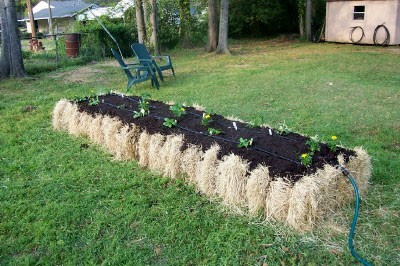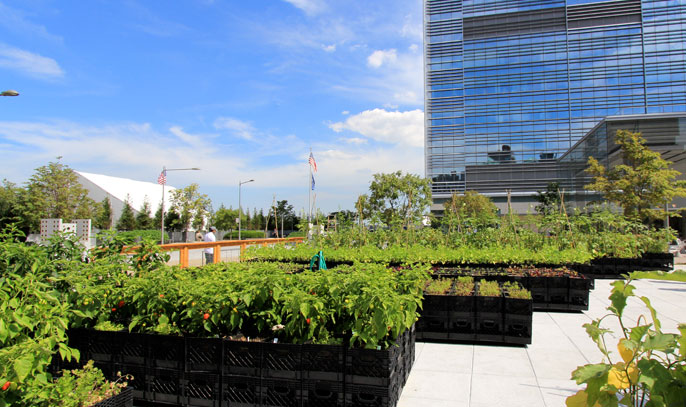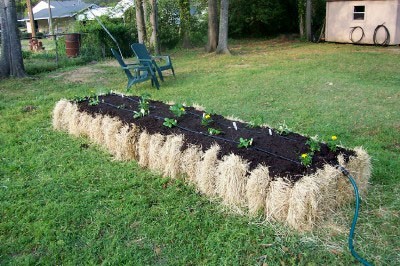Over at the Resilient Communities blog, there is always something cool going on. Not only do they discuss problems, they also offer solutions with an eye toward sustainability and, well, resilience. Here's a round up of nine pretty fantastic ideas offered up in 2012… and some of them may surprise you!

An example of a straw bale planter taken from Joel Karsten's book, Straw Bale Gardening.
Have no good soil available to you, but a little bit of space in which to plant some crops? Don't fret! Joel Karsten has your back. Straw bales can be utilized to create, in essence, raised beds. The process requires about 10 days of watering and amending the bales before planting — much like you would prep soil. After that, though, it's pretty much business as usual with the planting and growing process.
Growing and consuming local food is one of the pillars of resilience. But with climate change rapidly shifting precipitation and temperatures around the planet, once fertile lands are becoming less reliable for crops. Aquaponic systems allow for the farming of both fish and vegetables in one fell swoop. And they use considerably less water than traditional, soil-based planting.
Urban settings sometimes require mobility on the part of its citizens, a principle that certainly can hold true for urban agriculture. Today's vacant lot is tomorrow's newest development, so, creating portable, pop-up gardens is a nice work-around. Milk crates seem to be the vehicle of choice among nomadic gardeners because they are lightweight, porous, stackable, and inexpensive.

The milk crate garden at Riverpark atop an empty building lot at Alexandria Center in New York City.
So many people were left without power in the wake of Hurricane Sandy and, now, winter is rapidly descending with all its icy glory. Frustratingly, the infrastructure in the U.S. just can't handle a brisk winter storm, putting residents in colder climates at risk for blackouts. Being resilient in the face of power outages can be helped along by five simple tasks, including the installation of a backup generator and understanding your local power grid.
The harvesting of rainwater is a hot topic around the globe these days with some municipalities passing legislation to make it illegal. Nevertheless, resilient communities require these sorts of sustainable techniques. Because cistern-based catchment systems can be pricey, the savvy DIY-er may consider turning to ferrocement to build storage vessels.
Daniel Connell's open-source project allows a DIY approach to solar power. The Solar Flower can be fashioned out of readily available materials and tools any half-decent home tinkerer probably already owns (or can find at their local tool-lending library). Some of the uses of the energy include heating water and small spaces.

An image of Daniel Connell's Solar Flower system.
In emergency situations, as in everyday life, being physically fit is a boon. Fitness legend Arthur De Vany's expertise is summoned here for a simple, once-a-week program that involves only two steps:
-
An intense 30-minute workout with weights and high-stress isometrics. The goal is to drive all of major muscle groups into failure.
-
Wind sprints for 15 minutes. Sprint for 50 yards and walk the distance back until the time runs out.
Going hand-in-hand with fitness is, very often, weight loss. One way to build a resilient body is to trick it out of the feast or famine mindset through employing slow meals comprised of whole foods that digest slowly… lean proteins, complex carbohydrates, and fresh vegetables. Doing so provides a steady stream of caloric energy and allows the body to relax, put down its guard in relation to food.
Tough economic times force everyone to tighten their belts and cut back on seemingly unnecessary expenses. Unfortunately, one of the first things to go are dental visits. Many people just don't place a high-enough value on their dental health to pursue regular cleanings and check-ups. If you really can't afford to see your dentist on a regular basis, making some nutritional shifts can go a long way toward preventing cavities and plaque. By limiting the consumption of simple carbohydrates (bread, pasta, etc) and sugars (ice cream, candy, etc), your teeth — and your waistline — will greatly benefit.









